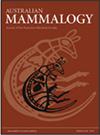Sniffing out danger: rapid antipredator training of an endangered marsupial
IF 1.2
4区 生物学
Q3 ZOOLOGY
引用次数: 4
Abstract
Globally, predator aversion training has assisted naive prey species to learn to evade introduced predators, improving translocation success. Eastern barred bandicoots (Perameles gunnii; hereafter ‘bandicoot’) are extinct on mainland Australia due to habitat loss and introduced predators, and are the focus of a long-term captive breeding and reintroduction program. Our trials showed that captive bandicoots failed to recognise cat (Felis catus) scents as belonging to a predator, suggesting prey naivety towards cats. We trialled five stimuli to elicit short-term fear behaviour in bandicoots. An automatic compressed air spray and automatic bin lid were most effective. We coupled these stimuli with cat urine during predator aversion training and presented them to bandicoots on three occasions. Bandicoots learnt to avoid the area containing cat urine, suggesting bandicoots are capable of learning new behaviours rapidly. Six trained and five untrained captive bandicoots where released onto Summerland Peninsular, Phillip Island (with cat densities at 1.1 cats/km2). Both had high survival and recapture rates 7 months after release. Training endangered species to avoid introduced predators could assist with long-term species recovery.嗅出危险:一种濒危有袋动物的快速反捕食者训练
在全球范围内,捕食者厌恶训练帮助天真的猎物学会躲避引入的捕食者,提高了迁移的成功率。由于栖息地的丧失和捕食者的引入,东斑斑斑蝶(Perameles gunnii;以下简称“斑蝶”)在澳大利亚大陆已经灭绝,是长期圈养繁殖和重新引入计划的重点。我们的试验表明,圈养的斑猫无法识别猫的气味,这表明猎物对猫很天真。我们试验了五种刺激来引发土匪的短期恐惧行为。自动压缩空气喷雾和自动箱盖是最有效的。在厌恶捕食者的训练中,我们将这些刺激与猫的尿液结合起来,并三次将其呈现给土匪。土匪学会了避开含有猫尿的区域,这表明土匪能够迅速学习新的行为。六只经过训练和五只未经训练的圈养土匪被释放到菲利普岛的萨默兰半岛(猫密度为1.1 猫/km2)。释放后7个月,两者的存活率和再捕获率都很高。训练濒危物种以避免引入捕食者可能有助于物种的长期恢复。
本文章由计算机程序翻译,如有差异,请以英文原文为准。
求助全文
约1分钟内获得全文
求助全文
来源期刊

Australian Mammalogy
ZOOLOGY-
CiteScore
2.50
自引率
8.30%
发文量
26
期刊介绍:
Australian Mammalogy is a major journal for the publication of research in all branches of mammalogy. The journal’s emphasis is on studies relating to Australasian mammals, both native and introduced, and includes marine mammals in the Antarctic region. Subject areas include, but are not limited to: anatomy, behaviour, developmental biology, ecology, evolution, genetics, molecular biology, parasites and diseases of mammals, physiology, reproductive biology, systematics and taxonomy.
Australian Mammalogy is for professional mammalogists, research scientists, resource managers, consulting ecologists, students and amateurs interested in any aspects of the biology and management of mammals.
Australian Mammalogy began publication in 1972 and is published on behalf of the Australian Mammal Society.
 求助内容:
求助内容: 应助结果提醒方式:
应助结果提醒方式:


